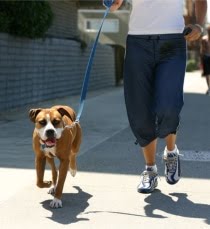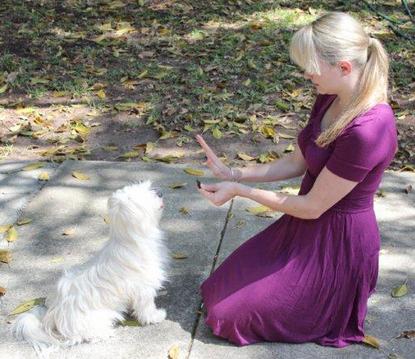Leave it Alone, Pooch!
How well behaved is your dog? Is he a “One word from me and he does as he pleases”...
Read MoreThe risk and chance of litigation and of Council action is profound and worrisome and you need to take immediate action.
When solving aggressive behaviour, your first step is to assess the risk. Once the risk is clear, then you need to implement the solutions that will reduce the risk as your first priority.
But it's also important that you determine the underlying reason for the aggression. Not all aggressive behaviours are equal and the more accurately you determine the reason "Why is it so?" the better your solution will be.
This sheet, Biting the Hand, goes into the risk in much more detail.
The risk of aggression that occurs to when walking your dog or dogs on the street depends on:-
While this information below is detailed, there is nothing better than receiving professional advice for problems as serious as this. You should not rely on this information alone to solve the problem you have with your dog. You are urged to consult with your own veterinarian who can refer you to a veterinary behaviourist. Alternatively you can contact us for personal advice if you prefer.
So with a big alert to the risk of aggression, let's get started
That's not an easy question to answer on a website but we will try. A proper assessment will lead to a diagnosis and your own veterinarian can help with that, or we can help if you prefer - to do that start with this assessment form.
There are certainly other causes of aggression to people you meet and sometimes there is more than one cause.

How well behaved is your dog? Is he a “One word from me and he does as he pleases”...
Read MoreReducing aggression of dogs towards people or other animals can be complicated. However, any...
Read More
Following is a useful key you can use to ensure you examine all aspects of your pet's behaviour and the information below is gathered under the headings of this key.
To structure your solution to this problem, consider this useful key which will help you to ensure all aspects of your pet's behaviour are considered.
Many medical conditions can make aggression worse.
While pain-related aggression would not be a common cause of aggression to people you meet, it could be a feature if a person you meet goes to pat your dog in a painful area or tries to pick your dog up when it is in pain.
This would be particularly so for a senior-age dog with, for instance, arthritis.
Changes in vision and hearing can also cause aggression to people you meet because your dog may be 'startled' by the approach of a person.
Other pain-inducing conditions such as itchy skin and ear infections can make a pet 'cranky'.
Now here's a job for you. If you are intending to ask the team at Cam Day Consulting to assist with the solution, or are being referred by your own veterinarian, we prefer pets to have a health check and MBA blood test done before your consultation with us.
Ideally a thyroid function test is also useful especially if your feel the aggression is 'abnormal'.
Please ask your vet to complete those tasks before attending your referral.
Teaching a dog not to be aggressive to people you meet is not as important as avoiding people on the street.
It's safer to presume you cannot teach your dog to be well-behaved towards people and therefore avoid interaction - at least until you see you are making progress with training.
However, when it comes to teaching a dog to be non-aggressive, remember that dogs usually cannot learn when they are 'immersed in the emotion of the moment'.
That means, when your dog is lunging, growling and barking at a person when you are out and about, no amount of yelling, screaming or hitting will prevent them being aggressive next time. Dogs don't learn like that. It won't work.
It is usually not helpful to concentrate on punishing the aggression because in most cases that makes the aggression worse, especially as so many aggressive dogs are anxious anyway and punishment makes them more anxious.
So, solving aggression is best done in incremental steps that are successfully achieved 'before' your dog is aggressive.
To learn about using a reward-based technique you need to know about a process called the circle of rewards and the leave routine.
The Leave Routine is like a speed-teaching system that's created from reward-based cognitive therapies. It simple terms, it's a fun, game play routine where your dog learns that the human English word 'leave' means the dog-lish action of 'don't bite'. But there's nothing magical about the word LEAVE unless you know how to use that to reward a targeted and defined outcome behaviour.
That's way too detailed to be shared here so follow the links in the paragraph before - they will open up a whole world of advice on how to teach your dog to be well-behaved in many situations - not just for aggression
Considering that your dog is aggressive while being walked, then you should also refer to this very important sheet Dreaded Walkies as it talks specifically about processes you can use to solve aggression while walking.
In that sheet you will read about the U Turn Technique and another precise process called the Perpendicular Pooch Routine.
You will find more details on the links above and from our team if you need to consult with us.
If your dog's problem is serious, we advise you to seek professional help from our team at Cam Day Consulting.

Management of a behaviour refers to those things you may do that won't solve the underlying 'emotion' that causes the problem, but stops the problem from occurring usually by AVOIDING it.
This article talks about managing aggression in detail.
To give an example, management often means keeping your dog away from people that you would normally meet on the street.
There are many ways of doing that but they include:-
If your dog barks excessively at pedestrians that pass by your home, you may need better fences to stop your dog seeing passing pedestrians, especially if you are on a busy street.
Attention to what you walk your dog on is also important. Some are better on head halters, some are better on collars and some are better on specially designed harness.
The use of muzzles is a debatable point but there are some advantages.
Before we leave the topic of management of aggression - you may want to also read this article on managing aggression to veterinarians or to dog groomers who need to handle your dog closely.
Reducing aggression of dogs towards people or other animals can be complicated. However, any...
Read MoreHow well behaved is your dog? Is he a “One word from me and he does as he pleases”...
Read More
For low-level cases of anxiety that cause aggression the homeopathic preparation Homeopet anxiety relief may be beneficial.
Pheromones such as the Adaptil Spray or Collar can be useful for aggression on the street.
You will need to apply the Adaptil Spray to a bandana you place on your dog's neck at least 15 minutes before you leave. If it works, the effect will last for about 1 - 2 hours. If you prefer to use the Adaptil Collar, that can be used continuously for approximately one month.
While they are not always needed, for the right problem they can literally be life-saving. Medications used for pet behavioural disorders are true mood-modifying medications and, when used correctly, should have minimal to no side effects.
However, all medications are prescription-only preparations and you will need to see your veterinarian or the vets at Cam Day Consulting for the supply of medications. Click here for more information on medications for pet behavioural problems.
So, solving aggression between dogs that you own involves the following: